
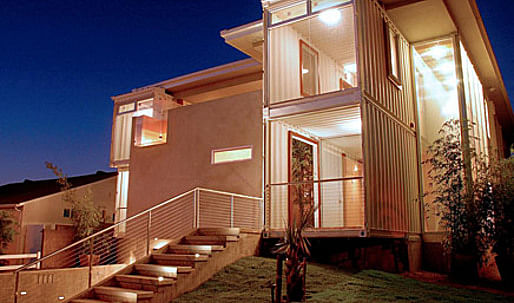
At 40ft long x 8ft wide x 9.5ft tall, the shipping container is a transcontinental, intermodial traveler carrying potato chips, children’s toys, designer bags, or a functional residential space.
by Martina Dolejsova
Architect Peter DeMaria, from DeMaria Design Associates, based outside of Los Angeles, has dedicated the past five years on taking the messengers of consumerism and converting them into role models for an environmental and economical housing solution. “Containers have a large number of structural characteristics that lend itself well to the production of buildings. In addition to that, they’re plentiful.”
↑ Click image to enlarge
Redondo Beach House by DeMaria Design Associates(Click on this and all of the images to get a detailed view)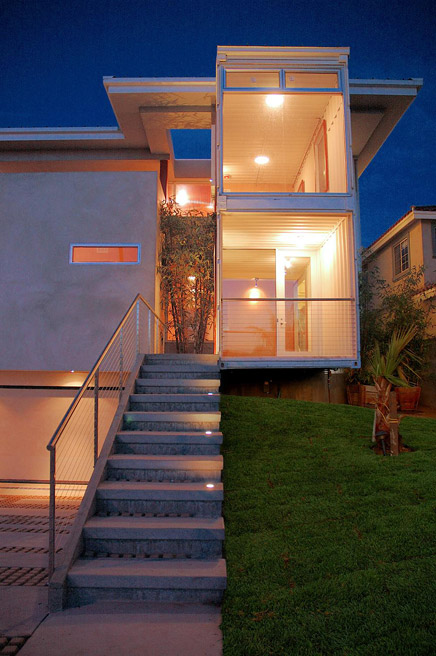
↑ Click image to enlarge
Redondo Beach House by DeMaria Design Associates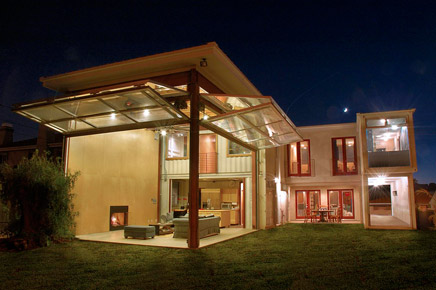
↑ Click image to enlarge
Redondo Beach House by DeMaria Design Associates
↑ Click image to enlarge
Container pool at the Redondo Beach House by DeMaria Design Associates
Yet, it was not an easy task to use shipping containers for a residential home. The Redondo Beach House, his first realized container home, a two story hybrid of eight containers and wood framing with a ‘container’ pool, required considerable thought into the engineering by the building authorities. “We had testing done, we did all of these things that no one else really has, and it was accepted (by the city). And now we’ve got it to the point where what we design complies completely with the Uniform Building Code .” A feat, DeMaria states as unprecedented and gives him the stepping point he needs to introduce this building method to more cities.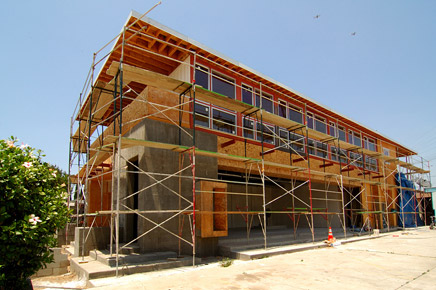
↑ Click image to enlarge
LA Community Center under construction
The Redondo Beach House, awarded by the AIA in 2007 for Design Excellence/Special Innovation, used the raw, bulky, industrial mass and transformed it into a slender rigid frame. Each container was positioned and stacked so that the ends could take advantage of becoming full height windows, maximizing the natural light into the linear structures. Negative spaces allowed for 20ft high ceilings in the main living. As equally thoughtful and innovative, an airplane hanger door opens up onto an adjacent courtyard, extending the outdoors into the interior, and serves as an awning for the conjoining spaces.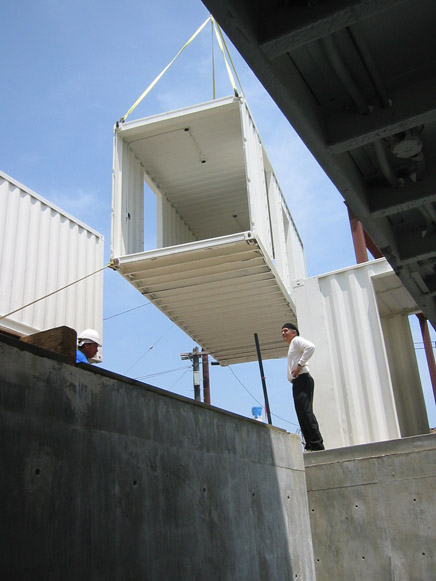
↑ Click image to enlarge
Container Placing
Every container is made to fit comfortably with other units. This has leant a hand in the rapid motion of building. “Conceivably, everything could have gone up in less than an hour. You could drive to the store and get groceries and find on your way home, what was just a foundation, is now a two story building,” says DeMaria, relating his experience in forming the structure for the Redondo Beach House. In reality, it took six hours to build because a truck was stuck in traffic, causing a ‘minor’ delay.
↑ Click image to enlarge
Mixed Use Container Project
Clearing the structural hurdles opened up the next step to a market that DeMaria feels is “underserved”. “People want good design,” DeMaria says, reflecting on what has made companies like IKEA popular with their ‘kit of parts’ and assured quality. Using the industrial influences of Ford and McDonalds and applying it to the housing market, he has created what he calls a “predictable process” for building a home.
↑ Click image to enlarge
McLoghlin Residence in Venice Beach, CA
Walking into one of the standardized 20 or 40ft steel units, you mysteriously forget while looking out of the floor to ceiling windows cut into the side, that not long ago this was stacked near a port. The teak wood flooring, now sanded and stained handled the rough loading and unloading of boxes and crates. In these rooms, a rich and warm space has been created by using what the cargo container offers: structure, walls, ceiling and floors. There is every component you need for a home. DeMaria, like other architects within the last decade, has acknowledged this, and is working, always pushing the boundaries.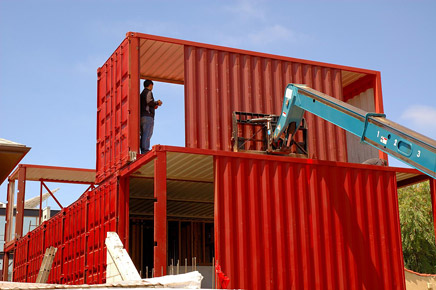
↑ Click image to enlarge
McLoghlin Residence in Venice Beach, CA
“This has given the best solution to the lot we have and the cost.” states client and mother Oona McLoghlin, who is finishing their container home in Venice Beach, CA, adding, “I think they are fantastic.”
↑ Click image to enlarge
McLoghlin Residence in Venice Beach, CA
Solving the various connection and structural problems, DeMaria now tries to think beyond the container, seeing it as a building block for new spaces. Launching soon, Logical Homes, a container prefab line , is a made to order residence changing the way we think about ‘home’.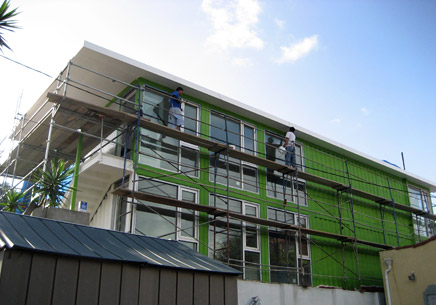
↑ Click image to enlarge
McLoghlin Residence in Venice Beach, CA
---
Shipping containers were standardized mid 20th century with the shipping giant Sea-Land, when trade showed significant increases from industrialism and a more efficient method was needed for delivering and exchanging goods. The containers are designed to fit on top of each other, stacking like Legos. They are durable to salt water, water-resistant when sealed, and reusable.
Today, there is a surplus of containers that are found sitting in yards along the coast. In the last twenty years, architects have begun to challenge and experiment with the function of these relatively abundant, simple and economical boxes for shopping spaces, offices and museums, temporary structures, and permanent residences.
Martina Dolejsova
Martina is an architect and writer currently living in Los Angeles.
9 Comments
shipping containers are great and all... doesnt his mixed use project look strikingly simliar to one of lot-eks proposals?
and wes jones..
after $$$$... whatever is left of the container... i think shipping containers had their glory days already. by the time you tame the beast with cash, you can sustain the baghdad zoo.
you know what i mean. i'd like to see the per sq. ft. budget disclosed.
i recently had an opportunity to buy a 20' container for $400 but decided against it. the thing weighed 5000 pounds! Mr. Fuller is turning over in his grave. . .oh, the weight (or firmness, oh, the post-commodity-turned-commodity. . . The "creative and novel incorporation of day-to-day objects" in architecture is refreshing, delightful, provocative, cross-disciplinary - but it seems that the container idea has been basically institutionalized at this point, however. It must be expensive. . . plus they seem to be just playfully incorporated into the larger house with most of these projects. Maybe there are other castaway items to use that are not already 100% recyclable (and not so very valuable as scrap metal!) that do not require the crane expense and what must be a lot of acetylene torching, welding, etc. They are boxey, though, and flat on top. . .which is still progressive after all these years. Total pads too, green martini time. . .
I've held back from commenting on containers while I've conducted research on this phenomenon. The architects who work these steel boxes are pioneering something that most of us desribe as simple yet at the same time... unattainable.
Architects love 'em or hate 'em and every architect I've spoken with starts out their conversation chatting about the containers with authority, but after a minute of questions, even they confess that they really don't know anything beyond how to stack them up, never mind how to create architecture with them. Those who do know are very few internationally and in the US can be counted on one hand. What separates them from the thousands of container enthusiasts is that they have made a commitment to making it happen.
Fighting the fight - they believe in the container as much as a mason believes in a brick. They are forced to clear political and engineering hurdles that are mountainous and yet their enduring commitment continues to expand and find further success.
I found this article long overdue with DeMaria at the pinnacle. Hate to disagree with those who commented above but research shows that while Wes Jones has a container website he has no real projects. Adam Kalkin, from New Jersey, did a really great project for Illy coffee and an art installation. Lotek, on the other hand, has produced some innovative container buildings and they are the other "movers" in this group with DeMaria. DeMaria is the innovator. He consistently applies this technology to many projects. In this article, there are at least four different buildings that he has under construction or has completed already. There are links out there to his other container work that includes artist's studios, a line of prefab homes, community centers, etc. This is the only office that is pushing the container dialogue with any conviction.
I, for one, am admiring from afar, DeMaria's efforts. It will be interesting to see how he develops his new found technology. Will it flop and become the basis for singular one of a kind projects or will he succeed in creating his "architecture as a product" - one that subscribes to the highest design principles and is simultaneously attainable by the masses. History is not on his side...but then again, it wasn't on Obama's either.
looks great, i like it. :-)
Don't shipping containers contain lead paint and the wood inside coated with pesticides and insecticides? At some point these two things have to be rid of and they create dust infecting people. I wonder what the percentage of harmful chemicals are left in the finished product and if they are killing people slowly or just retarding their future.
really nice design, I love this house, and it looks beautiful.
---------------------------------------
www.orchid3d.com
If we think about sustainability and recycling, this is the kind of projects that must be made.
Block this user
Are you sure you want to block this user and hide all related comments throughout the site?
Archinect
This is your first comment on Archinect. Your comment will be visible once approved.